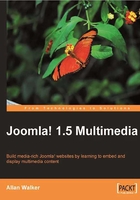
Multimedia and web accessibility
Website accessibility means that people who have disabilities can understand, interact, and navigate through web pages.
One of the main principles of web accessibility is to design websites and web software, which is flexible to meet different users' situations, preferences, and environments.
With the Web becoming an increasingly important resource for the sharing of information, many users are now going online for reference: health, commerce, government, recreation, media, and many other resources. It is essential that people wanting to utilize the Web have equal access and equal opportunities to these resources:

Another important consideration when building a website is that web accessibility has legal obligations in certain countries. Besides the important consideration to all of your site users, there could also be legal reasons why accessibility should be considered when building and maintaining your website.
Can a multimedia website be accessible?
It is possible for a multimedia rich website to also be an accessible website. However, the level of accessibility options you choose to implement into your website are decisions you need to make for your project. The decision basis will often include factors such as target audiences, country legalities, and project time and budgets.
There are a number of accessibility standards used around the Web, which provide accessibility guidelines and checklists to benchmark against. Examples of these are:
The Web Content Accessibility Guidelines (WCAG)
The Web Content Accessibility Guidelines (WCAG) have become a world standard for web accessibility, and falls into three 'compliance' categories:
- A (also known as Level 1)
A website must comply with all checkpoints in Level 1 otherwise one or more user groups will find it impossible to access information or functionality.
- AA (also known as Level 2)
A website should comply with all checkpoints in Level 2 otherwise one or more groups will experience significant barriers to access information or functionality.
- AAA (also known as Level 3)
A website may comply with all checkpoints in Level 3 otherwise one or more groups will find it somewhat difficult to access information in the document.
Section 508
Section 508 is a standard created by the US Federal Government. It contains 16 checkpoints for testing your website against. The first 11 checkpoints are exactly equivalent to the WCAG A (Level 1) guidelines. The last five checkpoints are partly based on the WCAG guidelines, but are more extensive. For further information about this standard, please search for Section 508 on the Net.
Site accessibility features are best considered at the start of a website project, and then having these addressed during development. It is much easier to take this approach rather than address this issue retrospectively. Fixing invalid site code and creating title or alt tags can consume hours of working time and often outweigh any budgets that have been put aside to make your content accessible.
There are a number of simple processes you can put in place to make your website more accessible. Trying to attain a higher level of accessibility will of course require a greater investment of time.
You may come across situations where the type of content you wish to offer on your site pages will never be accessible to certain audiences. This is where decisions must be made whether you make that content available in alternative formats. An example of this may be to include captions when playing a video, or to offer an audio version of text documents.
Throughout the development of your website, numerous software and online evaluation tools can be used to help determine the accessibility of your website pages.

An exhaustive list of these can be found on the Web, or at sites such as http://www.w3.org/WAI/ER/tools/complete.
More information on web accessibility
For further information and tools which can help you make your site accessible, please visit the following resources:
- http://www.w3.org/WAI/: Guidelines and resources from the World Wide Web Consortium (W3C).
- http://www.bbc.co.uk/accessibility: Resources to help make the Web more accessible to you.
- http://en.wikipedia.org/wiki/Web_accessibility: Wikipedia's page on accessibility guidelines.
- http://www.section508.gov/: Section 508 requires that Federal agencies' electronic and information technology is accessible to people with disabilities.
Web browser support for multimedia
The Web was originally a text only medium, with browsers only being able to display text in a single font, size, and color.
With the explosion of the Internet, website browsers can now view images, play audio and video. A further development of the World Wide Web has been the evolution of "streaming media" which allows the media playback to begin without the files being fully downloaded first.
There are many web browsers available. Some of these are suitable for specific purposes and others pride themselves on being the most lightweight, or the fastest browser available.
Most browsers have built-in media capabilities, which is an acknowledgement of the growth of website multimedia. Other browsers require plugins to play multimedia content. Plugins are programs, which extend your browser capabilities by making making them compatible with additional media types. When your browser encounters a multimedia file, it hands over the data to the plugin in order to play or display that file.
You may have heard of the plugin "Adobe Flash Player", which enables you to play Adobe movies through your web browser, or the "Windows Media Player" browser plugin, which plays streaming audio, video, and presentations saved in Microsoft formats. Without these plugins installed into the web browser, this media content on website pages cannot be effectively viewed:

This highlights the importance of offering multimedia material in numerous formats, or if that is not an option, to provide the site users with clear instructions about the media trying to load, and when possible, where to go and find a plugin in order to play it.